
Silene virginica, the fire pink, is a wildflower in the pink family, Caryophyllaceae. It is known for its distinct brilliant red flowers. Fire pink begins blooming in late spring and continuing throughout the summer. It is sometimes grown in wildflower, shade, and rock gardens.

Silene dioica, known as red campion and red catchfly, is a herbaceous flowering plant in the family Caryophyllaceae, native to Europe and introduced to the Americas.

Silene nutans is a flowering plant in the genus Silene, most commonly known as Nottingham catchfly.

Silene laciniata is a perennial herb in the family (Caryophyllaceae), commonly known as fringed Indian pink, cardinal catchfly, Mexican campion, Mexican-pink, and campion.
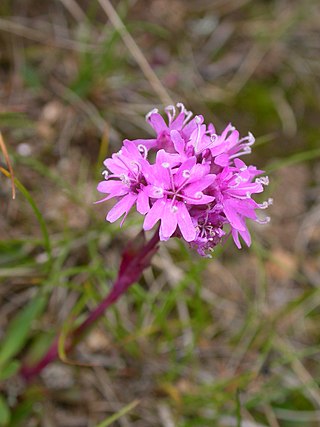
Silene suecica is a species of plant in the family Caryophyllaceae. Its common name is red Alpine catchfly and its natural habitat is the mountains of Norway and Sweden but it is sometimes found near the coasts and it is also found in the Alps and the Pyrenees, Greenland and North America.
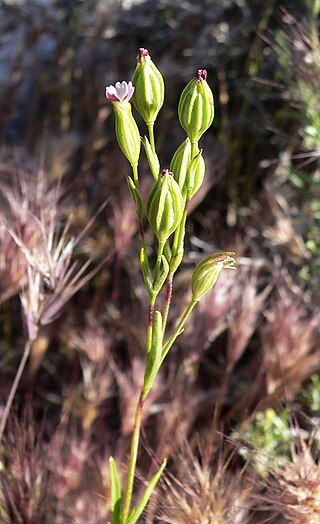
Silene antirrhina is a species of flowering plant in the family Caryophyllaceae known by the common names sleepy silene and sleepy catchfly. It is native to the Americas and has been introduced to Europe.

Silene campanulata is a species of flowering plant in the family Caryophyllaceae known by the common names Red Mountain catchfly and bell catchfly. It may be a synonym of Silene greenei.

Silene douglasii is a species of flowering plant in the family Caryophyllaceae known by the common name Douglas's catchfly.

Silene gallica is a species of flowering plant in the family Caryophyllaceae known by several common names, including common catchfly, small-flowered catchfly, and windmill pink. It is native to Eurasia and North Africa, but it can be found throughout much of the temperate world as a common roadside weed.

Silene noctiflora is a species of flowering plant in the family Caryophyllaceae known by the common names night-flowering catchfly, nightflowering silene and clammy cockle. It is native to Eurasia, but it is known on other continents as an introduced species and sometimes a weed. In North America, it is a common weed of grain crops in the Canadian prairie provinces and in much of the United States. It grows in fields and in other disturbed habitat.
Silene nuda is a species of flowering plant in the family Caryophyllaceae known by the common names western fringed catchfly and sticky catchfly.

Silene scouleri is a species of flowering plant in the family Caryophyllaceae known by the common names simple campion and Scouler's catchfly.
Silene taimyrensis, or Taimyr catchfly, is a herbaceous perennial in the family Caryophyllaceae. It is native to the Yukon and British Columbia in Canada and to Alaska. It is found to an elevation of a 1500 meters, growing in exposed subalpine to alpine locations with poor, rocky to sandy soils. It grows to a height of 40 cm in its native habitat and to twice that height as a garden plant; it has small, white to light pink flowers that grow in terminal clusters. S. taimyrensis is known in the fossil record from the Late Pleistocene.

Silene spaldingii is a rare species of flowering plant in the family Caryophyllaceae known by the common names Spalding's silene, Spalding's catchfly and Spalding's campion. It is native to eastern Washington, eastern Oregon, northern Idaho and northern Montana, where its distribution extends just into British Columbia, Canada. Much of its former habitat has been converted to agriculture and its range is now limited to the last remaining stretches of pristine prairie grassland in this region. It is threatened by the degradation and loss of its remaining habitat. It is federally listed as a threatened species in the United States and it is designated endangered by Canada's COSEWIC.

Silene ovata, the Blue Ridge catchfly or ovate-leaved catchfly, is a herbaceous plant in the family Caryophyllaceae. It is a perennial plant growing up to 1.5 m tall, that has numerous white flowers, each finely fringed with a tube. It has large opposite leaves without petioles, which are 5–12 cm (2.0–4.7 in) long and taper to a long point, and 2–5 cm (0.79–1.97 in) wide.
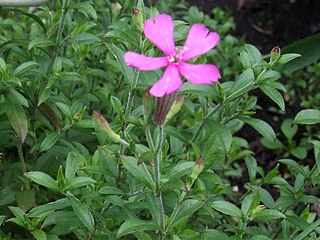
Silene schafta, the Caucasian campion or autumn catchfly, is a species of flowering plant in the family Caryophyllaceae, native to western Asia. Growing to 25 cm (10 in) tall by 30 cm (12 in) wide, it is a mat-forming semi-evergreen perennial, with narrow leaves and clusters of bright pink, five-petalled flowers in late summer.
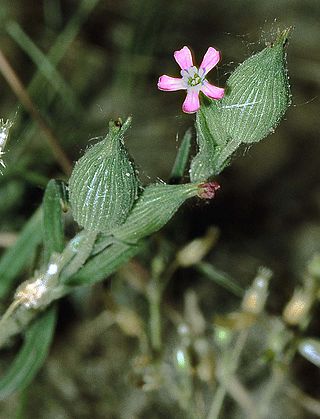
Silene conica is a species of flowering plant in the family Caryophyllaceae known by the common names striped corn catchfly and sand catchfly. It grows in dunes and sandy soils and is widespread in Europe and western Asia. It has an annual life history and produces self-compatible hermaphroditic flowers and occasional male-sterile flowers. Like other members of Silene section Conoimorpha, S. conica is readily recognizable based on its bright pink petals and the prominent, parallel veins on its calyx. In contrast to most flowering plants, S. conica appears to have a very rapid rate of mitochondrial mutation, and has the largest mitochondrial genome ever identified.

Silene italica is a species of plant native to Southern Europe and parts of Asia. It is also introduced to parts of the United States and Northern Europe.
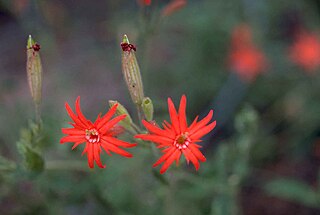
Silene rotundifolia, the roundleaf catchfly, is a species of flowering plant in the family Caryophyllaceae, native to the east-central United States. A perennial, it is typically found in woodlands to the west of the Appalachians, on cliffs and bluffs. It is closely related to Silene laciniata.

















